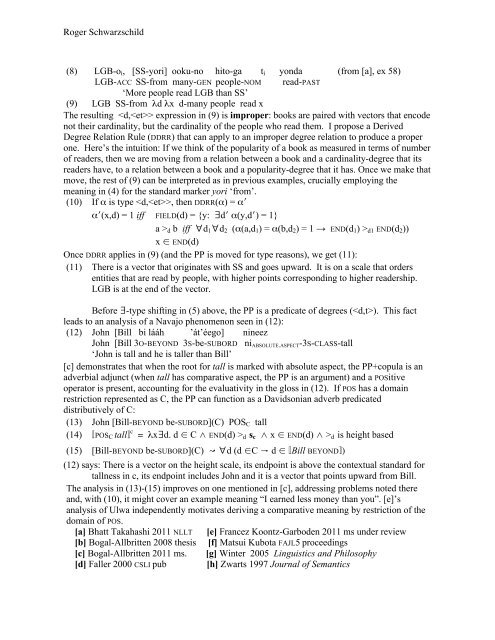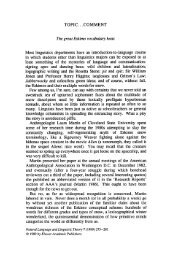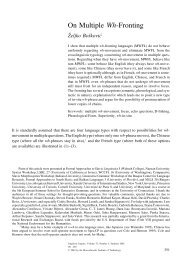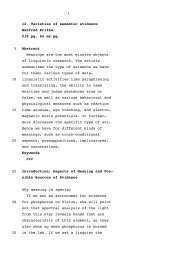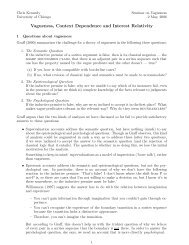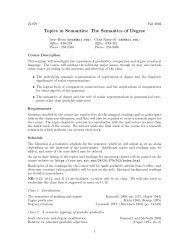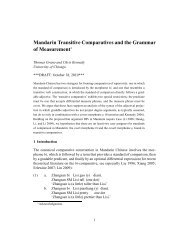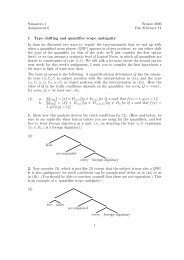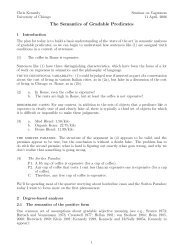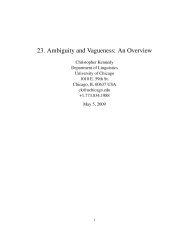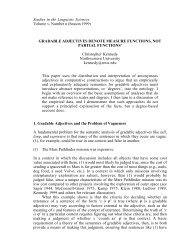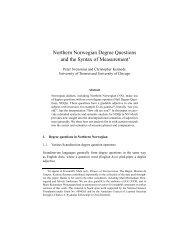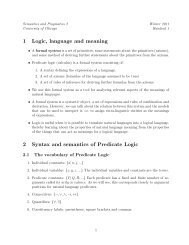On the natural history of negative polarity items - Syntax, Semantics ...
On the natural history of negative polarity items - Syntax, Semantics ...
On the natural history of negative polarity items - Syntax, Semantics ...
Create successful ePaper yourself
Turn your PDF publications into a flip-book with our unique Google optimized e-Paper software.
Roger Schwarzschild<br />
(8) LGB-oi, [SS-yori] ooku-no hito-ga ti yonda (from [a], ex 58)<br />
LGB-ACC SS-from many-GEN people-NOM read-PAST<br />
‘More people read LGB than SS’<br />
(9) LGB SS-from !d !x d-many people read x<br />
The resulting expression in (9) is improper: books are paired with vectors that encode<br />
not <strong>the</strong>ir cardinality, but <strong>the</strong> cardinality <strong>of</strong> <strong>the</strong> people who read <strong>the</strong>m. I propose a Derived<br />
Degree Relation Rule (DDRR) that can apply to an improper degree relation to produce a proper<br />
one. Here’s <strong>the</strong> intuition: If we think <strong>of</strong> <strong>the</strong> popularity <strong>of</strong> a book as measured in terms <strong>of</strong> number<br />
<strong>of</strong> readers, <strong>the</strong>n we are moving from a relation between a book and a cardinality-degree that its<br />
readers have, to a relation between a book and a popularity-degree that it has. <strong>On</strong>ce we make that<br />
move, <strong>the</strong> rest <strong>of</strong> (9) can be interpreted as in previous examples, crucially employing <strong>the</strong><br />
meaning in (4) for <strong>the</strong> standard marker yori ‘from’.<br />
(10) If " is type , <strong>the</strong>n DDRR(") = "&<br />
"&(x,d) = 1 iff FIELD(d) = {y: %d& "(y,d&) = 1}<br />
a >d b iff 'd1'd2 ("(a,d1) = "(b,d2) = 1 ! END(d1) >d1 END(d2))<br />
x # END(d)<br />
<strong>On</strong>ce DDRR applies in (9) (and <strong>the</strong> PP is moved for type reasons), we get (11):<br />
(11) There is a vector that originates with SS and goes upward. It is on a scale that orders<br />
entities that are read by people, with higher points corresponding to higher readership.<br />
LGB is at <strong>the</strong> end <strong>of</strong> <strong>the</strong> vector.<br />
Before %-type shifting in (5) above, <strong>the</strong> PP is a predicate <strong>of</strong> degrees (). This fact<br />
leads to an analysis <strong>of</strong> a Navajo phenomenon seen in (12):<br />
(12) John [Bill bi lááh ’át’éego] nineez<br />
John [Bill 3O-BEYOND 3S-be-SUBORD niABSOLUTE.ASPECT-3S-CLASS-tall<br />
‘John is tall and he is taller than Bill’<br />
[c] demonstrates that when <strong>the</strong> root for tall is marked with absolute aspect, <strong>the</strong> PP+copula is an<br />
adverbial adjunct (when tall has comparative aspect, <strong>the</strong> PP is an argument) and a POSitive<br />
operator is present, accounting for <strong>the</strong> evaluativity in <strong>the</strong> gloss in (12). If POS has a domain<br />
restriction represented as C, <strong>the</strong> PP can function as a Davidsonian adverb predicated<br />
distributively <strong>of</strong> C:<br />
(13) John [Bill-BEYOND be-SUBORD](C) POSC tall<br />
(14) “POSC tall‘ c = !x%d. d # C $ END(d) >d sc $ x # END(d) $ >d is height based<br />
(15) [Bill-BEYOND be-SUBORD](C) ! 'd (d #C ( d # “Bill BEYOND‘)<br />
(12) says: There is a vector on <strong>the</strong> height scale, its endpoint is above <strong>the</strong> contextual standard for<br />
tallness in c, its endpoint includes John and it is a vector that points upward from Bill.<br />
The analysis in (13)-(15) improves on one mentioned in [c], addressing problems noted <strong>the</strong>re<br />
and, with (10), it might cover an example meaning “I earned less money than you”. [e]’s<br />
analysis <strong>of</strong> Ulwa independently motivates deriving a comparative meaning by restriction <strong>of</strong> <strong>the</strong><br />
domain <strong>of</strong> POS.<br />
[a] Bhatt Takahashi 2011 NLLT [e] Francez Koontz-Garboden 2011 ms under review<br />
[b] Bogal-Allbritten 2008 <strong>the</strong>sis [f] Matsui Kubota FAJL5 proceedings<br />
[c] Bogal-Allbritten 2011 ms. [g] Winter 2005 Linguistics and Philosophy<br />
[d] Faller 2000 CSLI pub [h] Zwarts 1997 Journal <strong>of</strong> <strong>Semantics</strong>


